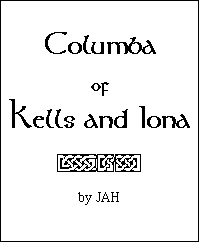
Columba (real name Crimthann) was born a prince; on December 7, 521 A.D., at Gartan in County Donegal; a nephew of Fergus Mor Mac Erca (the then king of Scotland) and Fergus' brother, the then reigning High-king of Ireland, Muircheartach Mac Erca. His father Feidlimid, descended from the Ui Neill, was chieftain of the territory of Tir-Conaill, in which he was born. And his mother, Eithne, from royal ancestry in Leinster, was daughter of a Munster chief, of the line of Cathair Mor. It was only in a time when, as then, the fires of Christianity glowed at white heat for some, that a man of such, and so many royal entanglements could turn his back upon wealth, rank and power like Moses had done, and give himself to God.Columba came to Kells and built his house into the grave-mound of the great Ith Cian king of Spain. He did this because he greatly revered Ith Cian; from whose name Cian aneas Mor, or Kells as it is known today, takes its name; and he wanted to be near to his grave, so he could try to communicate with him; absorb his energy and seek knowledge from him. If the original grave of Ith Cian was a stone cairn, then it is probable that the stones of Ith Cian's Cairn were used to build the present Columba's House.
Diarmuid Mac Caroll ( Cerbaill), High king of Tara from 539 until 558, is said to have granted the dun of Cenannus to Columba in the sixth century for the purpose of establishing a monastery but it appears that the grant took place after the death of Diarmait.

This revering of Ith Cian by Columba is confirmed by his prophecy titled Senanus (Cian aneas - "Cian from the South") in which the physical Second-Coming of Christ, to be King of Ireland, is foretold: an event that will finally defeat the English Davidic monarchy, unite Ireland under Christ's Sovereignty and bring peace and prosperity to all of its people.
SENANUS (ra chan - riot).
Impart to me (Columba), O Senanus (Cian aneas Mor),
Information concerning the latter ages of the world;
What shall be the condition of the race of people,
Who will not observe rectitude in their judgments.. . . . . . . . . . . . . . . . .
The King (Christ) son of Saxon will come
To join them across the sea;
He will part with the sovereignty
Of the Gall in the country whence he will come.The Galls and the Gaels of Ireland,
Will unite in one confederation;
Against the forces of the Saxons,
Their confederacy cannot be dissolved.The King (Christ) son of Saxon (Isaac's sons) will come
At the head of his forces;
In consequence of the protection he will extend to them,
Ireland shall be freed from her fears.One monarch (Christ) will rule in Ireland,
Over the Galls and the pure Gaels;
From the reign of that Man,
The people shall suffer no destitution.
Columba, who made Kells world-famous and without whom no-one outside of it would ever have heard of Kells, followed, as closely as he was able, from the information he had, the true teaching of Christ, as it had been brought to the British Isles by Jesus' own Disciples (the Culdees), who came with "the rich man" Joseph of Arimathaea and his niece the Virgin Mary and continued Jesus' work of founding and establishing the first christian community in the world, at Glastonbury, in Britain, as has been confirmed by numerous Vatican Councils. They came to the British Isles, where Jesus had grown up; for safety, because it was the only place not under Roman domination, when they fled the Holy Land during the Roman persecution of "The Followers of The Way (Christ)" and Mary returned home to her native England. The Blessed Virgin Mary; like Columba was in Ireland, in his day; was a member of the English royal family of her day. Jesus had commanded his twelve disciples (including Peter) not to go into the way or cities of the Gentiles (including Rome which Peter never even visited) but to go to the lost sheep of the "House of Israel" - the Ten "Lost" Tribes, which is another good reason why they came to the Brit-ish Isles. Brit means The Covenant in Hebrew and in Welsh and British Isles means the Islands of The Covenant People - the Israelite People.
Matthew 10:5 These twelve Jesus sent forth, and commanded them, saying, Go NOT into the way of the Gentiles, and into [any] city of the Samaritans enter ye not:
10:6 But go rather to the lost sheep of the "House of Israel".
Columba was tall and striking, powerfully built and with a dominating personality. He was a man of obvious ability with the skills of a poet and scholar as well as a natural leader. He was perhaps the greatest of all the Irish monks and certainly the most famous.
He was regarded by his contemporaries as a visionary, capable of astonishing predictions; prophecies and insights, reputedly a worker of miracles, a spiritual father-figure of awesome authority and undoubtedly very charismatic. He was known to be warm-hearted; generous and talented, with a hatred of injustice and oppression.
Columba ("Dove") faithfully kept the true Sabbath (Saturday) and The Passover, as Jesus taught his true followers to do, before Christ's teachings became corrupted by Simon Pater, the sorceror in the Book of Acts, and by others. It was Simon Pater; not Simon Peter who condemned him; that went to Rome. Simon Pater incorporated the teachings of Babylon into the Gospel and corrupted the teaching, by forming an organised-religion with priests worshipping on the Babylonian sun-worship religion's day of worship - SUNday; and celebrating the Sun Festival of Yuletide and the worship of Ishtar / Easter, a Babylonian goddess of fertility; hence "Ishtar Eggs", a fertility symbol, instead of celebrating the Passover with the sacrificial lamb, as Jesus did. The "Last Supper" was at Passover, not Ishtar, as explained in my Booklet "Passover Lamb not Easter Bunny." Easter/Ishtar is held at a different time of year and has absolutely nothing to do with Jesus.
This adherance to the true teaching of Jesus put the Prophet Columcille ("Dove") into conflict with the Roman church and they held a synod in 563 A.D., at nearby Teltown, to censure him, as a direct result of which he left Kells and his native Ireland and went to live on Iona (Jonah - "Dove"), where his uncle king Fergus Mor Mac Erc had built a church, wherein had been placed the Lia Fail Stone, that Fergus had taken from Tara to Scotland, for himself to be crowned upon. Columcille named a hill on Iona: "Cairn of the Back to Ireland", to leave a permanent reminder, that would forever show his disgust, at his treatment by the Irish clergy.
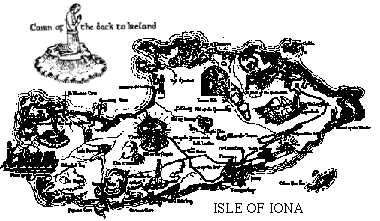
Iona and the Cairn of the Back to Ireland.
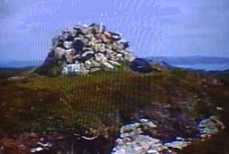
Picture of the Cairn of the Back to Ireland.
The first thing that Columba did on arriving at the Port of the Coracle in Columba's Bay on Iona was to go to his uncle Fergus's church and pay homage to the Lia Fail Stone, which he knew was destined one day, in the far distant future, to be the Throne of Christ's Glory on Earth, at Tara, in Ireland. This was also confirmed by the French Prophet Nostradamus in the sixteenth century, as can be seen in my Booklet "The Prophecies of Nostradamus affecting Meath."
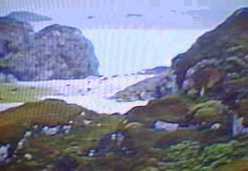
Port of the Coracle at Columba's Bay, Iona.
Once established on Iona, where he became custodian of the Lia Fail Stone, Columba set about making his famous Book of Kells in order to give people what he considered to be the true Gospel and so did not include in it things that he knew had already been corrupted by the church, in order to justify the church's own existence, in direct contradiction of Christ's commands to the faithful. He therefore limited the Book of Kells to the Four Gospels.
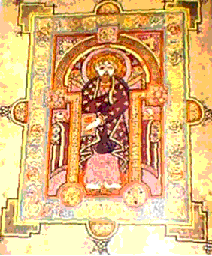
Columba is believed to have slept on a flagstone in Iona with a rock as his pillow. Being himself custodian of the Bethel - Lia Fail Stone, it is probable, as Columba too had visions from God, that the rock he used as his pillow was the Lia Fail - Jacob's pillow - the Stone of Destiny upon which Jacob saw his visions from God. There is a stone, in the museum at the abbey on Iona, that is wrongly thought to have possibly been Columba's stone pillow.
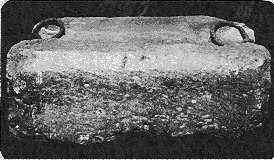
Lia Fail - Bethel - Jacobs Pillar Stone used as his pillow at Bethel
(above) and the stone in the museum on Iona (below).
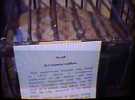 |  |
It must always have been his (and God's) intention for his Book or a copy of it to return to Kells, to try to enlighten the people of Kells, whom he loved and never forgot, and to haunt the clergy who had driven him out, which is exactly what happened around 800 A.D.
There is a possibility that from Iona along with his Book came his flagstone bed, because a relic known as Columba's Bed which was a stone slab six feet long and one foot thick, was kept in the roof space of Columba's House in Kells, until it was stolen in the 20th century.
His final counsel to his monks in Iona before he died, was: "Be at peace with one another and cherish sincere charity. If you follow the example of The Holy Father, God, the comforter of the good, will assist you and he (the Comforter) will intercede for you. He will not only minister to your needs in this life but will bestow upon you the eternal rewards that are prepared for those who obey His Commandments."

Columba's Shrine (rebuilt) where his bones were kept until they
were brought to Ireland because of the Viking raids.
In the Book of Kells he placed the Four Symbols that no-one except me (JAH) has ever been able to correctly interpret; the Man, the Lion; the Calf and the Eagle. Every historian world-wide has said that they represent the four disciples; as confirmed by historian William Battersby of Navan in his book on this subject; but the historians are all wrong. It is explained in my "Kells and Teltown" booklet, that they represent the Twelve Tribes of Israel to whom Jesus commanded that the Gospels were to be preached; the Eagle being the emblem of Dan, the fifth tribe of Israel - the Irish and Dan-ish people. So Columba was obeying Christ by placing the four symbols in his Book.
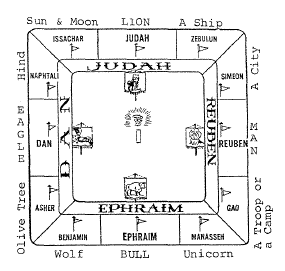
The wilderness Tabernacle Encampment showing the Four Symbols.
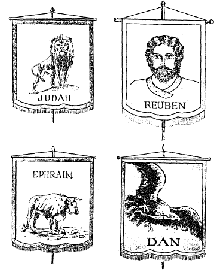
The Four Symbols - Brigade Standards of the Twelve Tribes of Israel
The Book known as "The Chief Relic of the Western World" was kept in Columba's church porticus, in Kells, from where it was stolen in 1007 A.D., and, along with the gold cover of the Book, the last few pages of the Gospel of John; that include Peter's denial of Jesus, talk specifically about Christ's thorough interrogation of Peter, about whether Peter loved Christ or not; were removed. These pages, written under the direction of the Prophet Columcille, were more accurate than in the church's authorised version and so posed a threat to the clergy, who Columba prophesied would only be interested in wealth and power and not in following Christ, without hesitation.
Senanus (Cian aneas - Kells):-
The clergy of the holy church,
Will be addicted to pride and injustice;
The advantages they will aim at,
Shall be the possession of worldly substance.
Between the sixth and eighth centuries a reform movement occurred, that of the Culdees (from Celi De or Culdich), and Columba was a leading reformer. The term Celi De has been translated as spouse or companion of God and Culdich as the "Servants of God" and "Certain Strangers", particularly strangers from a distance (the fleeing Disciples and Joseph of Arimathaea). The later Culdees wished to return to the stricter standards of the sixth century that had been set by Columba, whom they regarded as a model. But they were a minority group and did not succeed in influencing the wealthy churches. Between the seventh and twelfth centuries the church grew rich, just as Columba had prophesied and Kells became known as the "Splendour of Ireland."
At the time of Columba, in Ireland as elsewhere, only a small number of monks were priests. Learning in the monastic schools was based on the Scriptures and not on church doctrine; rituals and dogma. Columba, the most famous of the founders of monasteries, was himself not a priest of the Roman church, but had been ordained as a minister of the Celtic christian church, whilst he was in Ireland. On Iona he became a Culdee (Servant of the Lord) rather than be a priest, as Jesus had commanded his disciples not to be priests (Matthew 23:8).
Monks loved the Book (Bible) as a messenger of the Word of God and regarded their ascetic life as a sacrifice of the "Self", through prayer; study and manual work, in stark contrast to the rich priests and churches. Columba, even during his lifetime, enjoyed great respect, having renounced his high birth and wealth, preferring to serve God, than to be served by others, as Jesus had taught his disciples who came to Britain as the Culdees.
It was for holding these same principles that; as prophesied by Nostradamus in his Quatrain 3,65; pope John Paul the First was murdered on September the 28th in 1978, after only 33 days in office, in order to protect the church's obscene wealth, that John Paul the First had sworn to give back to the poor that it had been taken from.
It is also reputed that the Culdees (Servants of the Lord) in the British Isles, including Iona where Columba preached; who were considered by the Roman Church to be a threat to them; had a secret book written by the Apostle John (probably the correct version of his Gospel which Columba included in the Book of Kells and his 3rd Book of Revelation).
The 3rd Book of Revelation is available as part of the "King of kings' Bible", currently available exclusively from - http://i.am/jah/kofkad.htm
So, the question has to be asked. Was the theft of the Book of Kells an "inside job", done by members of the clergy to protect their wealth and power? If so, then the gold cover would have to go missing, to make it look like a robbery. How would a thief obtain access to such a priceless Book that had taken so many years to complete?
The "stolen" (?) Book of Kells was found three months later in the Abbey-field reputedly behind the Christian Brothers house in Kells and was pretty much undamaged, with just the few last pages of John's Gospel missing*. Why only those few pages? Why would the thief not keep the whole Book or destroy it all? Why just these few pages? Were there also notes and warnings from Columba taken from the Culdees' secret Book of John, to and about the church at the back of the Book of Kells, that were also removed? Did it also contain John's Third Book of the Apocalypse Revelation in which Christ condemns all the Priests of the Earth and teaches about re-incarnation and the time of the Second Coming, as being around the year 2000? To quote Shakespeare - Something smells fishy in the state of Dan ('s mark - the Tuatha de Danaan - the Irish ancestors).
* Some sources say that possibly up to 60 pages are missing from the Gospel of John. The last verse in the Book of Kells is reputed to be John 17:13, which is as follows:- And now come I to Thee; and these things I speak in the world, that they might have my Joy fulfilled in themselves.
The missing pages start with verse 14 onwards; verses 14-17 are as follows:-
John 17:14 I have given them Thy Word; and the world hath hated them, because they are not of the world, even as I am not of the world.
17:15 I pray not that Thou shouldest take them out of the world, but that Thou shouldest keep them from the evil (one - Lucifer), [in the world].
17:16 They are not of the world, even as I am not of the world.
17:17 Sanctify them through Thy Truth: Thy Word is Truth.
The known section of the Gospel of John that was removed is the section where Jesus, the Lord, contradicts the church's teaching and shows its entire foundation to be only made of, and built on, sand.It contains the following ten major points:-
1. Disciples would be sanctified through the Truth; the word of God in the Bible; not through a priesthood, exactly as Columba taught.
2. The Twelve Disciples were to remain on Earth, being re-incarnated (John 9:1-2; 5:14) until Christ comes again. This would have destroyed the Church's lucrative business, which says that anyone who gives money to them automatically goes straight to heaven, where Peter has the keys to the Pearly Gates. Peter has never gone to heaven, as he knew he wouldn't, because he had been told so by Jesus and so he asked about John, "If we are all to stay here on Earth; what [shall] this man do?"
John 21:21 Peter seeing him saith to Jesus, Lord, and what [shall] this man [do]?
21:22 Jesus saith unto him, If I will that he (also) tarry till I come, what [is that] to thee? follow thou me.
3. Jesus told Peter that the Holy Grail was not a physical object but the "bitter cup" he had been given by Father and must drink: the Self-sacrifice of the Crucifixion, that they and everyone must take up their cross daily and drink, before they could go to heaven.
John 18:11 Then said Jesus unto Peter, Put up thy sword into the sheath: the "Cup" which my Father hath given me, shall I not drink it? (the "Holy Grail")
4. Peter, even after already having been severely reprimanded, in front of everyone, and told, "Get thee behind me Satan" (in Matthew 16), still draws his sword and yet again tries, for Satan, to prevent God's Will from being carried out.
Matthew 16:23 But he turned, and said unto Peter, Get thee behind me, Satan: thou art an offence unto me: for thou savourest not the things that be of God, but those that be of men.
5. It contains also Peter denying three times that he even knew Jesus.
6. The truth about Bar Abbas - the Son of Abbas (Father), which would indicate that Jesus was married because he could not have a son unless he was married. That son could be either his own flesh and blood or his step-son, but, either way, he would have had to have been married for that to be the case.
7. The Truth that Jesus was not poor because he had a coat that was finely woven without seams and was so desirable that the Romans drew lots for it.
8. The truth also about Mary not being a perpetual virgin; having married Alphaeus Cleophas after Joseph's death and having had at least seven children:- Jesus; James; Jude; Simon; Joses and at least two sisters (Matthew 13:55-56) one of whom was called Salome (Mark 15:40).
Matthew 13:55 Is not this the carpenter's son? is not his mother called Mary? and his brethren, James, and Joses, and Simon, and Jude?
13:56 And his sisters, are they not all with us? Whence then hath this [man] all these things?
9. That the rich man, Joseph of Arimathaea, was his close blood-relative, or he could not legally have approached Pilate to claim the body.
10. That Peter did not love Jesus.
The correct version of the last few pages of John's Gospel that prove Peter did not love Jesus are as follows:-
John 21:15 So when they had dined, Jesus saith to Simon Peter, Simon, [son] of Jonah, lovest thou me more than these? He saith unto him, Lord; thou knowest that I like thee. He saith unto him, Feed my lambs.
21:16 He saith to him again the second time, Simon, [son] of Jonah ("Dove"), lovest thou me? He saith unto him, Lord; thou knowest how much I like thee. He saith unto him, Feed my sheep.
21:17 He saith unto him the third time, Simon, [son] of Jonah, lovest thou me? Peter was grieved because he said unto him the third time, Lovest thou me? And he said unto him, Lord, thou knowest all things. Jesus saith unto him, Feed my sheep.
In the correct translation quoted above, which is what it said in the Book of Kells, Peter admitted that he did not love Christ; he only liked him a lot and the Roman church claims to have built itself upon Peter; instead of on Christ. Christ knew the Romans would do this and so left his command that Peter must not visit Rome, in Matthew 10:5-6, and also his interrogation of Peter, in John 21:15-17, as an eternal witness that this was the wrong thing to do. Why else would Jesus interrogate Peter, to show he didn't love Jesus, and thereby grieve Peter by asking him three times if Peter loved him? If Peter had answered yes, Jesus would not have asked him twice more and grieved Peter, by, at the same time, in so doing, reminding Peter that he had denied even knowing Jesus, three times, after having arrogantly boasted, that if everyone deserted Jesus he would not, and swearing, before the Crucifixion, that he would die for Jesus.Doesn't it strike anyone else as being strange and illogical; that if Peter was the most important Disciple, as the church claims, and on whom the Roman church claims it has been built; that there is no Gospel of Peter in the Bible?
I will leave you to ponder and draw your own conclusions about why only the last few pages of the Book written by the Disciple that Jesus is reputed to have loved more than Peter and to whom He uniquely later gave His Apocalypse Revelation were removed and now move on to a much more important matter to us today - Christ's Throne - the Lia Fail.
What is the Lia Fail and why is Ireland called Inis Fail?The Lia Fail Stone set off towards its destiny, after it was found and used by Jacob as his pillow and then became the Pillar that he anointed; set up at, and named, Bethel, which means the "House of God". Bethel is where Jacob had his name changed from Jacob, which means the "Supplanter" (because he supplanted his brother Esau, with a bowl of potage/soup, for the Birthright of his father Isaac), to Israel, which means the "Champion of God", because he championed God's Cause, the cause of God or good, in the world.

The Lia Fail Stone / Jacob's Pillar.
The Stone, from that moment, was predestined to become Christ's Throne on Earth and it was taken by Jacob and his children into Egypt, when there was a famine in the land. The famine caused them to go to live in Egypt with their brother Joseph, whom they had previously sold into slavery and who had, through God's intervention, become the Egyptian pharaoh's right hand man.
Four hundred years later during the Exodus from Egypt under Moses and the Wilderness forty-year punishment wandering, the Lia Fail was carried on a pole, until the Israelites conquered Canaan and built Jerusalem. The Lia Fail or "Stone of Destiny" then became the Throne of king David, who slew Goliath the giant, with a stone from his sling.
Every one of the succeeding kings from David's line were crowned upon the Lia Fail - Jacob's Pillar*; which was kept in God's House, the Holy Temple, built by David's son, king Solomon, on Mount Moriah in Jerusalem; until king Zedekiah was overthrown by king Nebuchadnezzar of Babylon, for breaking The Covenant. Nebuchadnezzar of Babylon's soldiers destroyed Solomon's Holy Temple on Mount Moriah, which is the Holiest Place on Earth because it is where Abraham, centuries before, had offered to sacrifice his miracle son Isaac for God.
* 2 kings 11:14 And when she looked, behold, the king stood by The Pillar, as the manner [was], and the princes and the trumpeters by the king, and all the people of the land rejoiced, and blew with trumpets:
Jeremiah the Prophet rescued the Bethel/Lia Fail and The Ark of The Covenant and Zedekiah's daughter Teia Tephi and brought them to Tara in Royal Meath in Ireland, where on the 21st of June in 583 B.C. Teia Tephi married Eochaidh "Ollothair" Mac Duach/Dui, the Daighda, the Heremon - Ard ri or High king of Ireland, in fulfillment of God's prophecy to His Prophet Ezekiel, in the Old Covenant / Old Testament.
21:24 Therefore thus saith the Lord "I AM"; Because ye have made your inequity to be remembered, in that your transgressions are discovered, so that in all your doings your sins do appear; because, [I say], that ye are come to remembrance, ye shall be taken with the hand.
21:25 And thou, profane wicked prince of Israel, whose day is come, when inequity [shall have] an end,
21:26 Thus saith the Lord "I AM"; Remove the diadem (sovereignty), and take off the crown: this [shall] not [be] the same: exalt [him that is] low (Line of Zarah at Tara - Eochaidh), and abase [him that is] high (Line of Pharez in Jerusalem - Zedekiah).
21:27 I will overturn (1), overturn (2), overturn (3), it: and it shall be no [more], [overturned] UNTIL he come whose Right it is; and (4) I will give it [him - Shiloh/Christ (Genesis 49 v 10)].
That final destiny as Christ's Throne is here clearly stated in verse 27 as being the fourth and final overturn of the Throne, very soon.Jeremiah, who was buried in Cairn T at Loughcrew, not far from Kells, was the Prophet commissioned by God to fulfill His prophecy to Ezekiel, just quoted.
* Jeremiah 1:10 See, I have this day set thee over the nations and over the kingdoms, to root out, and to pull down, and to destroy, and to throw down, to build, and to plant.
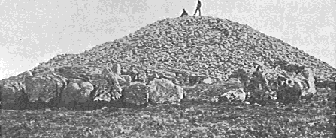
Cairn T.
The Lia Fail stayed in Ireland on The Forrad (The Inauguration Mound) at the Hill of Tara for over a thousand years, after Teia Tephi brought it with her from Jerusalem in 583 B.C. All of the kings of Ireland descended from her and Eochaidh were crowned on the Stone, right up to Muircheartach (Murdoch) son of Earc, who was Columba's uncle.
In around 500 A.D. Fergus Mor Mac Earc, Muircheartach's brother and therefore also an uncle of Columba, invaded and settled Western Scotland which was previously occupied by the Picts. Fergus wanted to be crowned, king of the (Scots) Irish who had migrated to Scotland, on The Lia Fail Stone and Muircheartach loaned the Stone to him, for that occasion.
The Lia Fail Stone was never returned to Ireland, but, as God prophesied, stayed in Scotland, where all of the Scottish kings were crowned on it, up to 1296 A.D.
Edward the First of England (Edward "Longshanks" in the film Braveheart) then invaded Scotland and removed the Stone to England. Edward took The Lia Fail to London, where it was placed in Westminster Abbey and all of the kings of England, right up to and including George the 6th., were crowned on the Stone.
To demonstrate the importance of the Stone of Destiny to you I will explain that during the bombing of London in the Second World War the Stone of Destiny was removed to Winchester Cathedral for safety. No similar action was taken with the Crown Jewels.
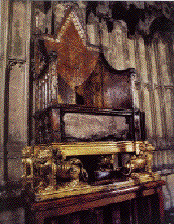
The Coronation Chair in Westminster Abbey, London.
In the early hours of Christmas morning in 1950, the Lia Fail (Stone of Destiny) was removed from Westminster Abbey by four Scottish Nationalists: Kay Matheson; Ian Hamilton; Gavin Vernon and Alan Stuart, who took it back to Scotland. They then sent a fake stone, which was cut from sand-stone that had been quarried near Scone in Perthshire, back to England and Elizabeth 2 was crowned upon it. Because Elizabeth 2 has never been crowned upon the real Lia Fail, she has not been officially crowned queen of Britain in the eyes of God.
The fake stone, known as the Stone of Scone, was sent back to Scotland in 1996, where it is now on public display in Edinburgh Castle. If you compare the two pictures, it should be blatantly obvious to you that they are two different stones.
The following pictures are from official photographs. The real Lia Fail / Stone of Destiny is supplied by Westminster Abbey; taken before the theft of The Stone on 25/12/1950 and The Stone of Scone is supplied by Edinburgh Castle.
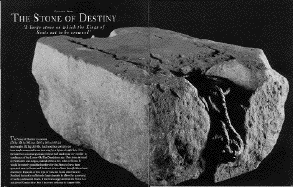
The Stone of Scone (above - weighing 336 lbs.) and Lia Fail (below - weighing 458 lbs.).

So what happened to The real Lia Fail - Stone of Destiny after the Scottish Nationalists removed it from Westminster Abbey, and where is The Stone's next place of Destiny?
As the Lia Fail is God's Throne of Israel and He knows all things before they happen, we can look at The Book He gave us (The Bible) to see what will happen to the Stone of Destiny. The following is a short excerpt from God's prophecy out of The Old Testament Book of His Prophet Ezekiel, previously quoted:-
21:26 Thus saith the Lord "I AM"; Remove the diadem (sovereignty), and take off the crown: this [shall] not [be] the same: exalt [him that is] low (Line of Zarah), and abase [him that is] high (Line of Pharez).
21:27 I will overturn (1), overturn (2), overturn (3), it: and it shall be no [more], [overturned] UNTIL he come whose Right it is; and (4) I will give it [him - Shiloh / Christ (Gen. 49 v 10)].
Verse 26 tells us that The Throne (Lia Fail) will be (and it was) taken from the Pharez branch (him that was high) of the tribe of Judah in Jerusalem and given to the Zarah branch (him that was low) of the tribe of Judah, who had settled in Ireland.
This happened, as already stated, when king Zedekiah of Jerusalem from the Pharez branch of the tribe of Judah, was overthrown by king Nebuchadnezzar of Babylon and princess Teia Tephi, Zedekiah's daughter brought the Lia Fail Stone to Ireland and married Eochaidh Mac Erc/Duach, the high king of Ireland who was from the Zarah (Red Hand - Genesis 38:28-30) branch of Judah, in the sixth century B.C.
The above was the first of the four overturns mentioned in verse 27. The second overturn was when the Lia Fail was taken from Ireland to Scotland in c. 500 A.D., overturning the Throne from the kings of Ireland, and the third overturn was when the Throne was removed from the Scots and taken to England in 1296.
God then tells us in the second half of verse 27, that the Throne shall be overturned no more, UNTIL He (Shiloh - Christ) comes whose Right it is; and that He (God) will give it to him (Christ). If we go to Genesis 49:9-10; we are told that the sceptre (sovereignty) will not depart from the line of Judah UNTIL Shiloh (Christ) comes (and then it WILL depart from Judah). In Genesis 49:22-24 we are told that from Joseph's seed (not Judah's) will The Shepherd (Christ) come.
The fourth and final overturn began in 1950 when the four Scottish Nationalists removed the real Lia Fail from Westminster Abbey and replaced it with the fake (Stone of Scone). Elizabeth 2 who is descended from the royal line of David from the tribe of Judah, was then crowned on that fake stone in 1953, so in actual fact was never officially crowned and she is not the sovereign of Britain in the eyes of God.
This fulfills the first half of the prophecy given in Genesis chapter 49 (the sceptre departs from Judah), and all that remains is for Christ, from Joseph's seed (Ephraim's line), to claim His Rightful place on God's Throne - Bethel - The Lia Fail - Stone of Destiny.
Did the police recover the Stone of Destiny? Definitely not!
In 1986, The Scotsman carried photographs 'supplied by Miss Marjorie S. Brock, who was treasurer of the 1320 Club, no longer in existence'. One photograph was captioned 'The Stone of Destiny, which has been on display in St Columba's Parish Church, Dundee, since June 1972.' The second photograph was of a plaque which read:-
The Stone of Destiny has been set here. An appropriate place for a symbol so venerable and significant in Scottish history. It has been given into the keeping of the Minister and Kirk Session of St (Columcille) Columba's Parish Church, Dundee, by the 1320 Club in association with Baillie (Municipal Officer and Magistrate) Robert Gray, of Glasgow, who helped to place the (fake) Stone in Arbroath Abbey on 12 th April, 1951. |
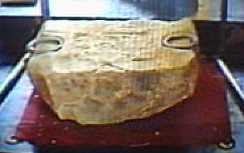
This stone is also obviously not the genuine Stone of Destiny but is another fake, presumably made by Baillie Bertie Gray. Again we have the connection with Columba of Kells and Iona being guardian of the Stone, because the Lia Fail was allegedly kept in Columba's church in Dundee, until the authorities found-out, by reading the above newspaper article and sealed-up the building with the alleged real Lia Fail still inside it. It was then rescued by the Knights Templar who have it at present, secreted away in Adamnan's Church at Dull in Perthshire. Yet again we have the link with Columba because Adamnan's Church is built into the grave-mound of Adamnan who wrote the "Life of Columba" around 685 A.D., shortly after Columba's death.
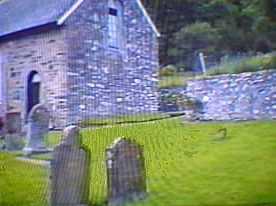
Adamnan's Grave-Mound and Church at Dull, Perthshire.
So why is Ireland called Inis Fail - the Island of Destiny? What IS Ireland's Destiny?
The real Lia Fail must now continue on its return journey; the next leg of which is to The Hill of Tara to be replaced on The Inauguration Mound, in place of the obscene phallic Baal pillar that presently stands there; in preparation for the fulfillment of the second half of God's Prophecy about Christ's Second-Coming, in Ezekiel 21:27 and Genesis 49:24.
This has to happen immediately, if not sooner for two very good reasons. The first reason is to release Ireland from the Curse it has been under for the last 150 years; as a punishment for naming a stone phallus God's Throne. The second reason; according to the Prophecies that Christ Himself left in the Gospel of Matthew, and in the Third Book of the Apocalypse Revelation to John; is that the climax of His Second Coming is very close indeed. The following is the parable Christ gave His disciples in reply to them asking when His Second Coming will be:-
Matthew
24:32 Now learn a parable of the Fig tree (Jews); When his branch is yet tender, and putteth forth leaves (1948), ye know that Summer [is] nigh:
24:33 So likewise ye, when ye shall see all these things, know that it (the end) is near, [even] at the doors.
24:34 Verily I say unto you, This generation shall not pass, till all these things be fulfilled.
24:35 Heaven and earth shall pass away, but My words shall not pass away.
The Fig tree has always been the emblem of the Jews (the religion, not the tribe of Judah). The 'when his branch is yet tender, and putteth forth leaves' occurred in 1948, when David Ben-Gurion announced, on 14/May /48, in Tel-Aviv, to the world, that the Jews had established a JEWISH STATE in the Land of Israel on 22/4/48. The 'Summer' referred to is Christ's forthcoming thousand year reign and 'this generation' is probably around fifty to sixty years from 1948, when 'all these things (will) be fulfilled.'
John's Apocalypse Revelation Book Three30:12 And behold, the Christ cometh quickly, for a millennium will pass and near another and there will be made a sign in the heavens. And you will know this "Star" that called the wise and all-knowing to Bethlehem. Seek there the "Star" (Matt. 24:30-31) at the appointed time, and all spirit will rejoice in the reward, even unto those who come out of the body (2 Cor. 5:8, 10), that every man according to his WORK shall be".
Nostradamus, the famous French Prophet who studied Columba's prophecies, also sheds some light on the subject and states that the Lia Fail will return to Tara and what will happen when it does; also that the great King of Warning will tell the world in the seven month of 1999 about the return of Christ; in the following two quatrains:-
1:43
Avant qu'advienne le changement d'Empire
Il adviendra un cas bien merveilleux:
Un champ mu, le pillier de paphire
Mis translat sur le rocher noilleux.Before the empire changes
A very wonderful event will take place:
The field (2m.x 2m.of turf) removed; the Pillar of Prophecy
(Lia Fail) put in place (on the Inauguration Mound at Tara); (the empire) changed on the gnarled stone (the Lia Fail - Stone of Destiny)-(as Christ is inaugurated King of Ireland)
10:72
L'an mil neuf cens nonante neuf sept mois
Du ciel viendra un grand Roi d'effrayeur
Rescuciter le grand Roi d'Angoulmois.
Avant apres Mars regner par bon heur.The year 1999 seven (sept) month (July or Sept-ember)
From heaven will come a great King of Warning (Prophet - Elijah - see the Old Testament Book of Malachi chapter 4)(Q. 4,29; Q. 6,100)
He will bring back to life the Great King of Israel (Christ from the Tribe of Joseph/Ephraim - Genesis 49:10; 22-24 k.J.A.V. of Bible).
Before: after war, reigns in good (God's) time (the
Seventh - Sabbath Millennium - 3rd millennium A.D)
Columba himself says in his prophecy called "The Force":-
This (Roman) wind, which will blow over us for a time,
And which will force us to deviate from our true course;
It is through the influence of this same wind from the East,
All the Gaels shall be ruined!I think it long until the King son of Saxon (Isaac's-sons),
Will come over the sea*, and not for love of him;
But in consequence of his coming, CHRIST,
The strangers shall be expelled by my kindred from Eire.* The King son of Saxon, who is here foretold should visit Ireland, is Christ in person, as Columba states clearly in line three. Senanus, treating about the same individual says:-
The King son of Saxon will come,
To them across the sea;
He will part with the sovereignty,
Of the Galls of the country whence he came.
For a more particular account of this King, see the Prophecy of Senanus.
Columba is talking plainly about Christ coming in a body from Joseph/Ephraim - of I-Saac's-sons - Saxons (Genesis 49:10; 22-24) to rule as King of Ireland, as also is Senanus.
Senanus:-
Impart to me (Columba), O Senanus (Cian aneas Mor),
Information concerning the latter ages of the world;
What shall be the condition of the race of people,
Who will not observe rectitude in their judgments.The King (Christ) son of Saxon will come
To join them across the sea;
He will part with the sovereignty
Of the Gall in the country whence he will come.The Galls and the Gaels of Ireland,
Will unite in one confederation;
Against the forces of the Saxons,
Their confederacy cannot be dissolved.The King (Christ) son of Saxon will come
At the head of his forces;
In consequence of the protection he will extend to them,
Ireland shall be freed from her fears.One monarch (Christ) will rule in Ireland,
Over the Galls and the pure Gaels;
From the reign of that Man,
The people shall suffer no destitution.
Columba's "Eire This Night":-
This new Eire shall be Eire the prosperous,
Great shall be her renown and her power;
There shall not be on the surface of the wide earth,
A country found to equal this fine country!
So now you know why Ireland is called Inis Fail (the Island of Destiny). It is because the Stone of Destiny is going to return to the Island of Destiny for its final destiny to be fulfilled, when Christ is inaugurated King of Ireland, on the Stone of Destiny on the Inauguration Mound at Rath na Ri (the Fort of the King) at Tara in Royal Meath.
To help God to fulfill His prophecies about Ireland with the least amount of difficulty, I ask all of the people of Scotland and Ireland to help us to help you. The sooner the obscene phallic stone is removed from Tara and replaced by the real Lia Fail, the sooner the Curse of Tara will be lifted from the Irish people, and the sooner Ireland can live in peace; unity and prosperity with Scotland under Christ's Sovereignty.
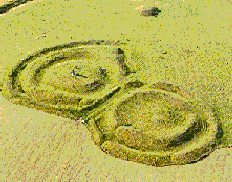
The Inauguration Mound (An Forradh) at Tara,
Co. Meath, Ireland.
One of Columba's Prayers
My dearest Lord,
Be thou a bright flame before me,
Be thou a guiding star above me,
Be thou a smooth path beneath me,
Be thou a kindly shepherd behind me,
Today and for ever more.